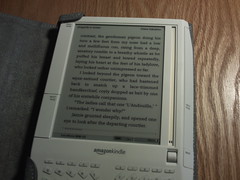posted on December 4th, 2009
The story’s not done yet, but I hit the National Novel Writing Month (www.nanowrimo.org) monthly goal of 50,000 words. Somehow I managed to get enough writing in even during that final week—which included Thanksgiving, a trip back to my home town for a class reunion, and time with my girls—to fall across the finish line around 8 p.m. on November 30. I’ll pick the story back up in January, along with two other novels that need some serious revision. I’m thinking 2010 will be a year of revision and editing rather than more new writing (aside from finishing the 2009 NaNo). Time to get these puppies out there in the world!
In other news …

KINDLE UPDATE: ONE YEAR OUT
I’ve had my Amazon Kindle for about a year now. I’ve tried to make note of any book-buying patterns that have changed since getting the Kindle. And, as you might expect, there are some:
First, when I see a book I’d like to read/own, I see if a Kindle edition is available. Usually, there is. Assuming there is a Kindle edition, I then ask myself a series of questions about that particular book:
1. Do I need to have it immediately? Like, really immediately? 1 vote for the Kindle edition. (Available in about 30 seconds.)
2. Is it available only in Kindle and mass market paperback? 1 vote for the Kindle edition. (I hate mass market paperbacks—hard on the ol’ eyes.)
3. Do I want the physical copy taking up ever-dwindling shelf space in my house? 1 vote for the Kindle edition.
4. Will I want to lend the book to anyone else in the future? 1 vote for the dead-tree copy. (Still not possible to lend Kindle books, which doesn’t really bother me. I don’t lend out books all that often anyway.)
5. Will I want a first edition copy or a hard copy that the author might someday autograph? 1 vote for the dead-tree copy. (Still kinda hard to autograph the Kindle edition of a book, which goes without saying, although apparently I said it anyway.)
6. What is the price comparison between the two editions? If all other variables are not relevant, then 1 vote for the cheaper edition, if it is a LOT cheaper. (Sometimes Kindle editions are oddly high-priced, even near the price of print editions, and this puzzles me, since I so often hear about the high cost of paper, ink, and book production in general.)
Let’s use a book I bought just this morning as an example: Robert Sawyer’s Flashforward.
Trade paperback edition: $8.51.
Kindle edition: $7.99.
The prices of the two editions are unusually close for a book that’s not a current bestseller. Which one did I purchase? Going through my list of questions, I decided that I didn’t need the physical edition of the book taking up room on my shelves. I also didn’t see myself lending the book out, and I doubt I’ll run into Mr. Sawyer while carrying a copy of the book, to give me the opportunity to get it autographed. Plus, I was extremely curious to start reading it … soon. Like, right now.
The Kindle edition won, and I had the book on my Kindle before I could get across the room to pick it up. In the past year, I’ve found the Kindle to be indispensible for traveling and for leisurely reading in my wing chair at night. Having just purchased Stephen King’s 1,000-page Under the Dome in first edition hardcover (the Kindle edition isn’t due out for a few more weeks), I was immediately reminded of two of the Kindle’s best features: It’s easy to prop up and read without the weight of a large book or the annoyance of the pages flipping backwards if you shift in the chair. And, the adjustable font size is a balm to my eyes (having recently been diagnosed with ocular rosacea as well as the omnipresent chronic dry eye).
And, if I’m not done with King’s tome by the time the Kindle edition comes out, I might purchase that edition too just to continue to read in more comfort. And yes, I know that’s precisely what the publishers want me to do. For some authors, such as King and also Diana Gabaldon, I’ll keep buying first edition hardcovers no matter what. The Kindle editions are merely icing on the cake.
A year later, I’m still buying print books—probably too many for my own good—but the Kindle has given me options for many of my future purchases. All told, I’m buying more book content than I did pre-Kindle. And I know I’m reading a lot more than I did a year ago. Happily so. For hours on end when I can manage it.
And that can only be a good thing.
